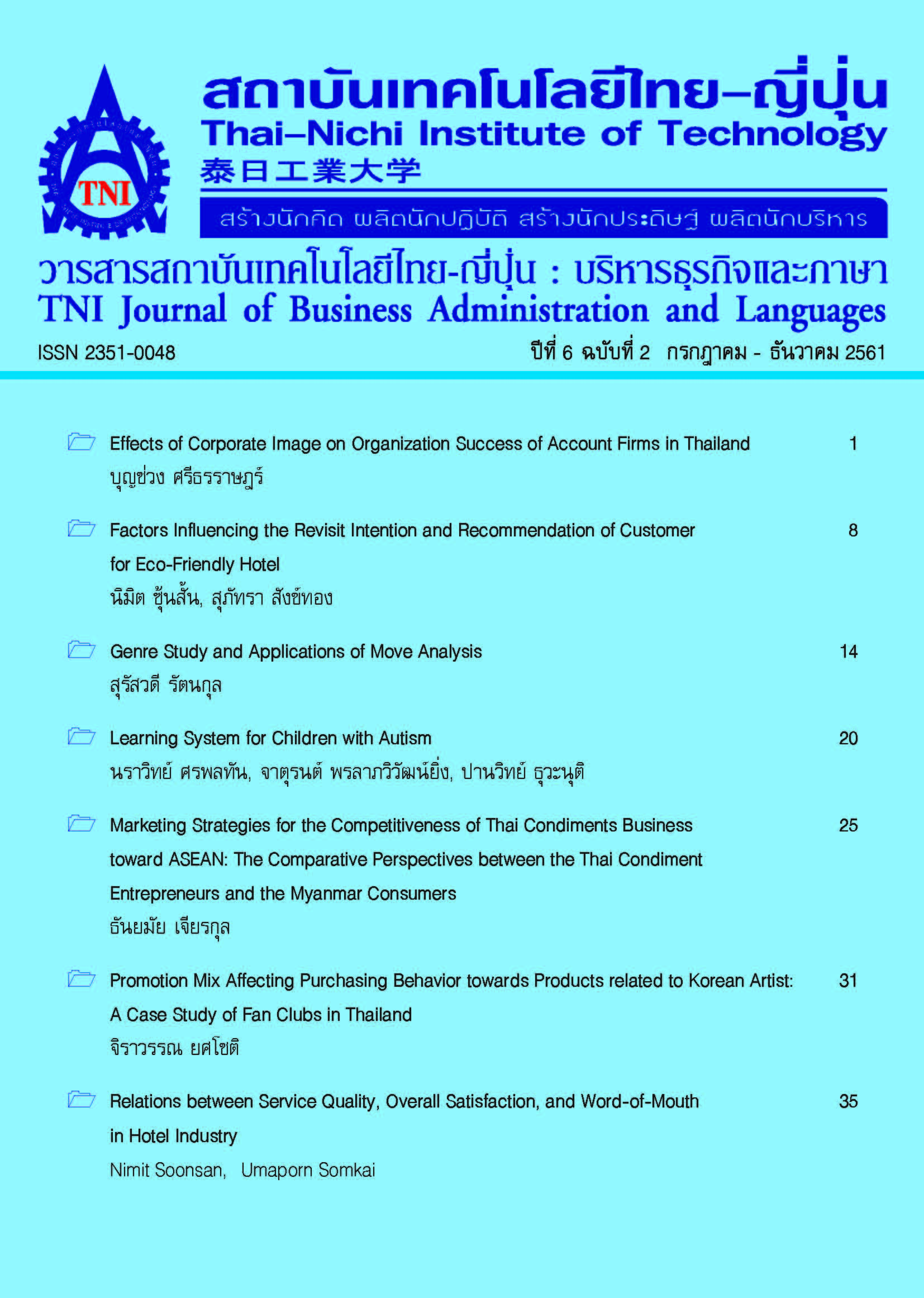การนำ Swim Lane Diagram มาใช้ในการปรับปรุงกระบวนการทางธุรกิจ
Main Article Content
บทคัดย่อ
บทความนี้มีวัตถุประสงค์เพื่อนำเสนอผลจากการศึกษาและปรับปรุงกระบวนการทางธุรกิจของสินค้าวัสดุปิดผิวไฮกลอสของบริษัทตัวอย่าง โดยประยุกต์ใช้ Swim Lane Diagram เป็นเครื่องมือในการสำรวจและวิเคราะห์กระบวนการทางธุรกิจในปัจจุบัน ทำการวิเคราะห์ปัญหาที่เกิดขึ้นในกระบวนการ ผ่านแนวคิดด้านการปรับปรุงกระบวนการอย่างต่อเนื่อง (CPI) และแนวคิดด้านการปรับปรุงกระบวนการทางธุรกิจ (BPI) เพื่อปรับปรุงกิจกรรมในกระบวนการ โดยการลดต้นทุนที่ไม่จำเป็น เพิ่มประสิทธิภาพในกระบวนการทำงาน และลดของเสียที่เกิดขึ้นในกระบวนการผลิต จากการศึกษาและวิเคราะห์ปัญหาในกระบวนการทางธุรกิจพบว่า มีปัญหาลำดับของกิจกรรมไม่เหมาะสมทำให้ตอบสนองลูกค้าได้ช้าและไม่สามารถควบคุมการผลิตให้ได้ตามแผนการผลิต การตรวจสอบคุณภาพทั้งวัตถุดิบและสินค้าที่ผลิตเสร็จไม่มีประสิทธิภาพ และการทำงานในกระบวนการผลิตที่ไม่เหมาะสมก่อให้เกิดของเสียเป็นจำนวนมาก ผลจากการปรับปรุงพบว่า กิจกรรมภายในกระบวนการทางธุรกิจ ลดลงจาก 23 กิจกรรมเหลือ 17 กิจกรรม ระยะเวลาการตรวจสอบวัตถุดิบลดลง 42.89% และระยะเวลาการตรวจสอบสินค้าที่ผลิตเสร็จ (ประกันคุณภาพ) ลดลง 33.33% นอกจากนี้ของเสียจากกระบวนการผลิตลดลงจาก 11.15% เป็น 0% ซึ่งทำให้บริษัทตัวอย่างสามารถลดต้นทุนได้ถึง 463,633 บาท/ปี หรือ 38,636 บาท/เดือน หรือคิดเป็นประมาณ 19.83 % จากปีก่อนหน้านี้
Article Details
นโยบายการรับบทความ
กองบรรณาธิการวารสารสถาบันเทคโนโลยีไทย-ญี่ปุ่น มีความยินดีรับบทความจากอาจารย์ นักศึกษา และผู้ทรงคุณวุฒิในสาขาบริหารธุรกิจและภาษา ที่เขียนเป็นภาษาไทยหรือภาษาอังกฤษ ซึ่งผลงานวิชาการที่ส่งมาขอตีพิมพ์ต้องไม่เคยเผยแพร่ในสิ่งพิมพ์อื่นใดมาก่อน และต้องไม่อยู่ในระหว่างการพิจารณาของวารสารอื่นที่นำส่ง ดังนั้นผู้สนใจที่จะร่วมเผยแพร่ผลงานและความรู้ที่ศึกษามาสามารถนำส่งบทความได้ที่กองบรรณาธิการเพื่อเสนอต่อคณะกรรมการกลั่นกรองบทความพิจารณาจัดพิมพ์ในวารสารต่อไป ทั้งนี้บทความที่สามารถเผยแพร่ได้ประกอบด้วยบทความวิจัย ผู้สนใจสามารถศึกษาและจัดเตรียมบทความจากคำแนะนำสำหรับผู้เขียนบทความ
การละเมิดลิขสิทธิ์ถือเป็นความรับผิดชอบของผู้ส่งบทความโดยตรง บทความที่ได้รับการตีพิมพ์ต้องผ่านการพิจารณากลั่นกรองคุณภาพจากผู้ทรงคุณวุฒิและได้รับความเห็นชอบจาก กองบรรณาธิการ
ข้อความที่ปรากฏภายในบทความของแต่ละบทความที่ตีพิมพ์ในวารสารวิชาการเล่มนี้ เป็น ความคิดเห็นส่วนตัวของผู้เขียนแต่ละท่าน ไม่เกี่ยวข้องกับสถาบันเทคโนโลยีไทย-ญี่ปุ่น และคณาจารย์ท่านอื่น ๆ ในสถาบัน แต่อย่างใด ความรับผิดชอบด้านเนื้อหาและการตรวจร่างบทความแต่ละบทความเป็นของผู้เขียนแต่ละท่าน หากมีความผิดพลาดใด ๆ ผู้เขียนแต่ละท่านจะต้องรับผิดชอบบทความของตนเองแต่ผู้เดียว
กองบรรณาธิการขอสงวนสิทธิ์มิให้นำเนื้อหา ทัศนะ หรือข้อคิดเห็นใด ๆ ของบทความในวารสารวิชาการ สถาบันเทคโนโลยีไทย-ญี่ปุ่น ไปเผยแพร่ก่อนได้รับอนุญาตจากผู้นิพนธ์อย่างเป็นลายลักษณ์อักษร ผลงานที่ได้รับการตีพิมพ์ถือเป็นลิขสิทธิ์ของวารสารสถาบันเทคโนโลยีไทย-ญี่ปุ่น
หากต้องการสอบถามข้อมูลเพิ่มเติมที่
- กองบรรณาธิการ วารสารสถาบันเทคโนโลยีไทย-ญี่ปุ่น
- ฝ่ายวิจัยและนวัตกรรม สถาบันเทคโนโลยีไทย-ญี่ปุ่น
เลขที่ 1771/1 สถาบันเทคโนโลยีไทย-ญี่ปุ่น ซอยพัฒนาการ 37-39 ถนนพัฒนาการ แขวงสวนหลวง เขตสวนหลวง กรุงเทพมหานคร 10250 ติดต่อกับคุณพิมพ์รต พิพัฒนกุล (02) 763-2752 , คุณอาริสา จิระเวชถาวร (02) 763-2600 Ext. 2704 Fax. (02) 763-2754 หรือ E-mail: JBAL@tni.ac.th
References
R. Seethamraju, “Business process management: a missing link in business education,” Business Process Management Journal, vol. 18, no. 3, pp. 532–547, Jun. 2012.
S. Umit Firat et al., “Managerial processes: business process that sustain performance,” International Journal of Operations & Production Management, vol. 31, no. 8, pp. 851–891, Jul. 2011.
C. Rodmorn, “An analysis of a business process in an information management system for Production planning: a case study of a metal Products manufacturer,” Master’s thesis (Technology of information system management), Mahidol university, Nakhon Pathom, Thailand, 2010.
A. Fleischmann and C. Stary, “Whom to talk to? A stakeholder perspective on business process development,” Universal Access in the Information Society, vol. 11, no. 2, pp. 125–150, Jun. 2012.
E. P. Ezeonwumelu, S. Ozuomba, and K. Constance, “Development of swim lane workflow process map for enterprise workflow management information system (wfmis) : a case study of comsystem computer and telecommunication ltd (cctl) eket,” European Journal of Engineering and Technology, vol. 3, no. 9, 2015.
W. E. Deming, Out of the crisis. Cambridge, Mass.: Massachusetts Institute of Technology, Center for Advanced Engineering Study, 1986.
S. Page, The power of business process improvement: 10 simple steps to increase effectiveness, efficiency, and adaptability, 2nd ed. New York: AMACOM, 2015.
G. E. Kalb and G. M. Masson, “Continuous Process Improvement and the Risk to Information Assurance,” Journal IEEE Software, vol. 19, no. 1, pp.84–86, Jan. 2002.
เดวิด. แมนน์, จากวัฒนธรรมแบบโตโยต้าสู่วัฒนธรรมแบบลีน. กรุงเทพฯ: อี.ไอ.สแควร์, 2551.
J. P. Womack and D. T. Jones, Lean Thinking : Banish Waste And Create Wealth In Your Corporation. New York: Free Press, 2003.

